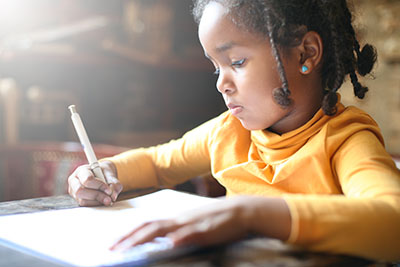Preparing for the new school year: emphasizing student experience, linguistic diversity is crucial

Valuing Students’ Linguistic and Cultural Diversity
In the book “Funds of Knowledge: Theorizing Practices in Households, Communities, and Classrooms,” the concept of Funds of Knowledge is presented under a simple premise: “People are competent, they have knowledge, and their life experiences have given them that knowledge.”
As educators prepare for instruction for the fall of 2020, they will have to consider their students’ experiences more than ever. The global impacts of COVID-19 and the Black Lives Matter movement and U.S. court decisions on immigration (including recent rulings on DACA) and the LGBTQ+ community have filtered into the lives of every member of society, including our youngest students. By integrating students’ home and community experiences in lessons, teachers help students apply those connections to classroom learning. Likewise, school and district administrators should support teachers with opportunities and resources that can help inform their implementation of community and home practices on instruction. One way to accomplish this could be by inviting local community leaders and activists for conversations about happenings in their neighborhoods.
Funds of Knowledge also promotes drawing on students’ language and culture. As fall instruction is designed, educators need to be mindful of students’ linguistic and cultural backgrounds. These elements of student identity provide great opportunities for multilingual learners to make connections to the classroom content.
As Dr. Tara Yosso, a professor at the University of California-Riverside who examines critical race theory, outlines in a journal article, recognizing the ways in which education prioritizes dominant standardized languages can enable teachers to create windows of opportunity to bring forth the linguistic diversity of their multilingual learners. By recognizing the value of bilingualism and multilingualism, educators can have a positive impact on their students’ success inside and outside of the classroom. As educators plan for teaching and learning this fall, be it in person or online, finding ways to integrate language and culture can enhance students’ learning experiences.
Translanguaging Practices
Continuing the conversation on valuing students’ linguistic and cultural diversity, translanguaging is a practice that multilingual students may use to learn new content and that teachers can incorporate in teaching and learning to further validate student identity.
In the book “The Translanguaging Classroom: Leveraging Student Bilingualism for Learning,” the authors define translanguaging for instruction and assessment as a practice that enables students to use all their languages for learning academic content, while at the same time providing opportunities to develop linguistic practices that support their socio-emotional development and bilingual identities.
Providing opportunities for students to express their translanguaging practices is important, but educators may feel uneasy about proper implementation. Something to consider is that every student has a unique learning experience and educators should facilitate that learning in a way that leverages the student’s linguistic and cultural practices. In response to the pandemic, much of the learning is happening at home. Remote learning can create opportunities for educators to further enrich the learning experience by leveraging and elevating the linguistic practices of the students’ families through translanguaging.
During the learning cycle, educators should allow students to use all their languages to enhance their learning of new concepts. In the classroom, students can discuss with one another (in a safe and healthy manner), explaining new concepts to peers by using the language that helps them express themselves best. As students listen to their peers explain concepts, they also learn and adopt the language used. While Spanish should be used widely in the Spanish classroom, allowing students to use English or other languages to learn academic skills will facilitate the way in which they are ultimately able to express those skills in Spanish as well. These efforts must expand beyond the bilingual teacher. School and district level personnel should create a culture in which teachers can support students’ use of all their languages for instructional purposes.
In remote learning spaces, teachers should encourage students to discuss their learning with their family members by using the language that is most common at home. By engaging with family in discussions of what they have learned, students are able to break down concepts and reframe those in a way that makes the most sense to them. This enhances their understanding of the concepts. By using different languages, the students’ engagement with the material grows.
Want to learn more?
Focus Bulletin, Educación en el mundo actual: una visión para el futuro, coming soon!
WIDA Español’s Focus Bulletin, Educación en el mundo actual: una visión para el futuro, to be released in August 2020, will expand on the concepts presented in this article. Additional topics to be discussed include educational equity, technology, supporting students’ socio-emotional needs, developing dynamic lessons for student engagement and how educators can support families outside the classroom. The Focus Bulletin will also expand on teacher practices and provide suggested resources for each topic. Look for it on the WIDA Español webpage and the WIDA Twitter and Facebook pages.
Stay informed about WIDA Español
To receive occasional messages about WIDA Español resources, products, tools and services please click on the WIDA Español interest area of the manage subscriptions page in the WIDA Secure Portal (login required) or the newsletter signup page on the WIDA website.
About the Authors
Erika Rosales is a Human Resources Coordinator at WIDA. She supports the HR team in the recruitment, hiring, onboarding process and employee relations with a focus on equity, diversity and inclusion. Erika also co-leads the WIDA Social Justice Change team.
Samuel Aguirre is the Director of WIDA Español and oversees all products and services developed for the program. WIDA Español is a program at WIDA that focuses on developing and delivering resources and professional development for educators (in teaching and administrative roles) supporting the Spanish language development of multilingual learners.





